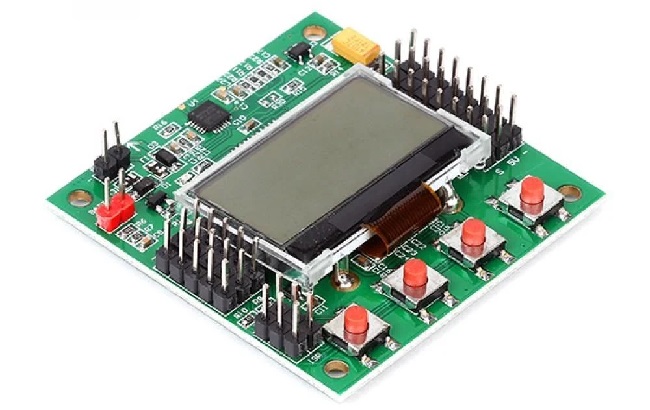Flight Control Board Selection
All Multi-rotors have four main components, the frame, power electronics (brushless motors and ESCs), power unit (battery and power distribution boards), and finally, the most important, the control unit (flight control board and transmitter/receiver unit).
The performance and operation of the first three components largely depend on flight controllers, which are the central electronic processing units. They have a variety of built-in sensing devices such as accelerometers (for tilt, orientation, and axial acceleration), gyroscopes (for rotation and motion vectors), GPS or Global Positioning Systems (for geographic location coordinates), compass (for directional guidance), and much more. Flight controllers, depending on their complexity and usage, have some or all of these components. The flight controller collects data from all these devices using complex algorithms and programmed settings to facilitate the desired flight, combining it with input from the pilot.
Therefore, understanding which flight control device to choose for multi-rotors based on its purpose, usage scenarios, desired flight characteristics, and expandable toolset is crucial for enthusiasts or hobbyists.
Class I: Beginners
Class I flight controllers are designed for individuals new to drone platform design and flight. Typically, they are pre-programmed for basic flight and simple functions that beginners can use out of the box without going through a complex setup and adjustment process, but these boards offer the option to do so if needed. They usually contain sensors necessary for basic flight, such as accelerometers and gyroscopes. These boards have limited built-in instruments and are designed for everyday flight and learning purposes, with no additional connection points to attach advanced sensor extensions or positioning tools. They provide an excellent platform for new pilots to practice drone flying and controlling, gaining a sense of understanding the different features of electronic devices in the air. They offer basic adjustment options that beginners can change on their own to achieve desired flight characteristics. Designed with a plug-and-play mechanism to provide novice learners with a smooth and stable flight experience.
Key Features
- Basic Input and Output ports
- Designed for beginners
- Low response time
- Limited built-in instruments
- Low-cost, adequate performance
- Simple and easy user interface
- Limited scope for feature expansion
The KK2 Flight Control Board series can be cited as an example of these Class I flight controllers.
These are among the best boards for beginners, featuring a built-in LCD screen for setting up and configuring the board and drone without the need for any computer. With a high performance-to-cost ratio, these boards are widely used for learning drone control and flight principles. The built-in software package has an excellent graphical user interface that is easy, powerful, and effective. The KK board series requires low voltage requirements, around 3.3-5 volts. It is also one of the few boards that support camera gimbals to keep onboard cameras stable in the air.

Class II: Acrobatics and Racing
Class II flight controllers are designed for agile multi-rotors built for racing and high-speed flights from scratch, so they are very compact and ultra-lightweight. These flight controllers have a very specific purpose, such as having very fast processors and high responsiveness, making them an excellent choice for drones that need to be lightweight, powerful, aerodynamic, and highly maneuverable. These flight controllers have very detailed software packages that allow experienced multi-rotor pilots to configure the board in complex parameters to achieve desired flight characteristics. They come with a highly precise sensor array (more than Class I) including accelerometers, gyroscopes, temperature and voltage sensors, rotation vector sensors, and much more. These boards can also accommodate GPS modules.
Key Features
- Compact and Lightweight
- Faster built-in processor for agility
- Built-in software algorithms tuned for high response rates
- External software package with good developer community support for configuration
- Easy connection setup process
- Durable circuit structures resistant to impact and collisions
The SP Racing Flight Control Board series can be cited as an example of these Class II flight controllers.
The SP Racing F3 Flight Control Board is designed to provide a flight performance based on a highly precise sensor set and unique I/O capabilities in a small and extremely lightweight form factor, also using a new generation CPU that supports high bit rates. This board has many great features starting with integrated hardware-based floating-point units for precise flight calculations and faster ARM-Cortex M4 core SOC with a reliable STM32 F3 processing unit. It offers various features like automated flight that have amazed many pilots so far.
Class III: Advanced Flight
Advanced class flight controllers are designed to be the absolute best solution for any multi-rotor flight purpose, with highly advanced microprocessors, additional sensors, GPS, and special I/O connection points for extensive expansion options. These boards have the best software packages with excellent developer community support, making them the best choice for unusual flight purposes like automatic flight and offering countless advanced features that have amazed many pilots. Due to the versatility of these boards, they are widely used for research studies, remote sensing purposes, transportation and delivery drones, photography, and security purposes.
Key Features
- Most advanced electronics
- Wide variety of highly precise built-in sensors
- Extensive expansion options through I/O connection points
- High performance.
- Excellent software package and support
- Overall the best choice for all pilots
The Ardupilot APM series can be cited as an example of these Class III flight controllers.
It allows the transformation of any fixed-wing, rotary-wing, or multi-rotor vehicle (even cars and boats) into a fully autonomous vehicle; equipped to perform customized GPS missions. This board is designed for vehicles (especially multi-copters and drones) that need to be set up to keep the compass away from sources of magnetic interference as far as possible to avoid attractive impedance. (In the case of fixed-wing aircraft, it is generally easier to mount the APM far enough away from the motors and ESCs to avoid attractive impedance, so it's not that simple, but the APM 2.8 provides more adaptability in this case and is a suitable choice. It is designed to be used with the Compass-equipped 3DR uBlox GPS, so the GPS/Compass unit can be mounted farther away from the APM than from itself.

These are different flight control boards available in the market. These flight control boards have made drone construction much easier. We hope this blog post guides you in choosing the flight control board for your drone. To explore all flight control board products, click
here.
.png)



